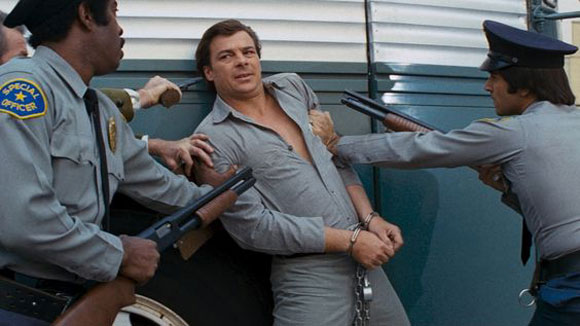As Assault On Precinct 13 arrives on limited edition Blu-ray to celebrate its 40th anniversary, Martin Carr revisits John Carpenter’s classic siege thriller and finds that it remains a technical marvel…
 This John Carpenter classic is a masterclass in economy. From the building of tension, bringing together of component parts to create conflict and finally resolution. There are few that come close to Carpenter in his heyday. Using players who defined the term ‘character’ actor we are quickly shown situation, reaction, culmination and motive for each character with concise camerawork, minimal dialogue and perfect pacing.
This John Carpenter classic is a masterclass in economy. From the building of tension, bringing together of component parts to create conflict and finally resolution. There are few that come close to Carpenter in his heyday. Using players who defined the term ‘character’ actor we are quickly shown situation, reaction, culmination and motive for each character with concise camerawork, minimal dialogue and perfect pacing.
Carpenter understood the importance of showing rather than telling, which means the premise of an isolated police precinct, sick prisoners in transit and the imminent dread of an attack are all mapped out in fifteen minutes. By the time we hit the half hour mark everything is in place. A dynamic between characters has been well established and Carpenter can just focus on action beats and editing.
Austin Stoker’s Ethan Bishop is idealistic, morally sound and comes to the screen fully formed in ten minutes. Economy of character is also something Carpenter excels at here and Stoker has a few minor conversations, which establish his personal reasons, back history and journey to this point. They never feel contrived or slow things down, while his opposite number Napoleon Wilson played by Darwin Joston is sketched with similar restraint. Other minor players include Kim Richard’s Katy who is written and played with backbone, relying on steely stares and skill with a firearm.

Although Assault on Precinct 13 is definitely dated it remains a strong piece of workreminding us how much of a pioneer Carpenter was back in the Seventies. Whether it was the first film with a physical clock on screen, cross cutting between criminals and cops as time passed, or the use of the camera as crosshair, tension is built. More than anything he uses the camera to observe people rather than create set pieces. Everything is shown. When the gunman scans the people looking for a target, when the policeman is tripped up by Wilson, or the chuck away line said in the precinct to Bishop over black coffee; all reveal character.
Which is why by the time we get to the siege we are in that police station with those people. Classic tropes including cut telephone lines, power outages and no cavalry arriving until the final reel are all present and correct. Others have tried to replicate this type of film but few have done it with the skill and clarity of vision on display here. Which is why classics of the genre such as Assault on Precinct 13 and The Taking of Pelham 123 should be left well alone. They represent a time of economical filmmaking where the sole reason had little to do with big money.
With the news that Max Landis has signed on to remake his father’s crowning glory An American Werewolf in London, things unfortunately do not look hopeful. Having said that if anyone should do it perhaps Landis has the right. Much more so than anyone who attempts to fill William Friedkin’s boots when remakes of The French Connection start being bandied about. However such conversations can wait for the moment we are faced with such an appalling idea. Right now just be thankful that gems like Assault on Precinct 13 exist and revel in the genius which is John Carpenter circa 1976.



